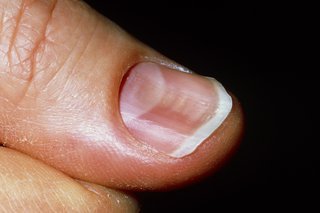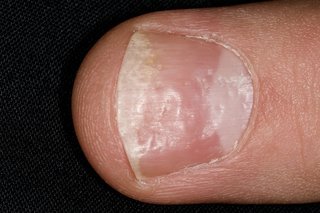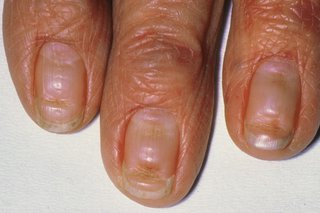Nail problems are common. They can affect your fingernails and toenails. Usually they are not caused by anything serious.
It's normal for nails to:
- get thicker or break easier (brittle) as you get older
- be harder, softer or more brittle during pregnancy - but they usually get better in the 6 months after having your baby
- bruise or change colour, loosen and in time fall off after an injury
Fingernails that fall off after an injury should grow back within 6 months.
Toenails can take up to 18 months to grow back.
Causes of nail problems
Most damage to toenails and fingernails has a clear cause like:
- a fungal nail infection
- an injury
- biting your fingernails
- staining your nails, for example, by smoking or putting on a lot of nail varnish
- not cutting your nails often enough, or cutting them at an angle
- your hands often being in water or cleaning products
Nail problems can sometimes be a symptom of:
Treatment for nail problems
There are things you can do to help with common toenail and fingernail problems.
Do
-
wear rubber gloves if your hands are often in water or you use cleaning products a lot
-
clean your nails with a soft nailbrush
-
put hand cream on your fingernails and fingertips often
-
cut your toenails and fingernails often - it may help to cut nails after a shower or bath
-
cut straight across the nail
-
cut injured, loose toenails and fingernails back to where they are still attached - this helps them to grow back the way they should
Don't
-
do not ignore fungal infections on your skin, such as athlete's foot
-
do not cut your nails down the sides - cut straight across the top to help you from getting an ingrown toenail
-
do not clean under your nails with sharp objects
-
do not bite or pick your fingernails or the skin around them
-
do not wear shoes that pinch your toes, especially when exercising
Talking to your pharmacist
Talk to a pharmacist if the look of your nail bothers you or it's painful.
Treatment for a fungal nail infection is not needed unless it is painful.
Non-urgent advice: Go to your GP if:
- if you notice a new black line or a new black spot under your nail
- you do not know why a fingernail or toenail has changed shape, changed colour or fallen off
- the skin around your nails has become sore, red, swollen and warm (paronychia), this can be a sign of an infection or ingrown toenail
Non-urgent advice: Go to a podiatrist if:
- your toenails are too tough to cut or you cannot reach them
- your ingrown toenail needs treatment
Podiatrists and chiropodists are specialists who treat the foot and toenails.
Your GP may be able to refer you for podiatry or chiropody. You can also pay privately to go to a podiatrist or chiropodist.
Symptoms of nail problems
Check your symptoms below to find out what type of nail problem you may have.
Loose, brittle or damaged nails
Problems with the skin around your nail
Nails that change shape and thickness
Nails that change colour
Yellow nails
You can get yellow nails from putting on nail varnish often.
But the most common causes of a yellow nail are fungal nail infections or nail psoriasis.
Other causes include:
- lymphoedema
- long-term damage to your airways caused by bronchiectasis
- some medicines, such as mepacrine or carotene
- chronic paronychia - infection of the nail fold
White nails
If most of the nail has turned white and has not become detached from the nail bed, it could be the sign of two things:
- a fungal nail infection
- decreased blood supply to the nail bed, known as ‘Terry's nails’
White nails with reddened or dark tips (Terry's nails)
Terry's nails are usually white with reddened or dark tips and can be a sign of a wide range of medical conditions, including:
- liver cirrhosis (scarring and damage to the liver), about 8 in 10 people with cirrhosis have Terry's nails
- liver, kidney or heart failure
- diabetes
- chemotherapy
- an overactive thyroid
- malnutrition
- iron-deficiency anaemia
White lines running across nails
White spots or streaks are normal and nothing to worry about. White lines can come up if you have been sick and if growth has been disrupted.
Parallel white lines that extend all the way across the nails and are not grooved are known as Muehrcke's lines. They are a sign of low levels of protein in the blood.
They can happen as a result of liver disease or malnutrition.
Green-black nails
Green-black nails can be caused by overgrowth of bacteria called pseudomonas, especially under loose nails.
It can be treated by putting antibiotic eye drops underneath the nails or soaking the affected nails in an antiseptic solution or vinegar.
Brown nails
Brown nails can sometimes be caused by:
- thyroid disease
- pregnancy
- malnutrition
- using nail varnish often
Red or yellow drop or oil drop under the nail
If it looks like you have a drop of oil under your nail or a drop that is the colour of salmon, you may have psoriasis of the nail.
Half white, half brown nail
Fingernails that are half white and half brown (brown near the tips) can be a sign of kidney failure, where the kidneys stop working properly.
Up to 4 in 10 people with kidney failure have "half-and-half" fingernails.
Half white, half brown fingernails sometimes happen in people living with AIDS or who have had chemotherapy.
Dark stripes running down the nail (melanonychia)
Dark stripes running down the nails is called linear melanonychia. It is common in black people age 20 and over. In most cases it's normal.
Dark stripes in 1 nail only
Do not ignore dark stripes in 1 nail only. This is because it can sometimes be a type of skin cancer (subungual melanoma).
Go to your GP so they can check your dark stripes.
Subungual melanoma affects the nail bed. It usually only affects 1 nail. It will also cause the stripe to change in appearance.
For example, it may become wider or darker over time. The skin around the nail (the nail fold) might also change colour.
Red or brown little streaks under the nails
If you have little red or brown streaks underneath your nails, it's likely they're splinter haemorrhages. These are lines of blood caused by tiny damaged blood vessels.
A few splinters under 1 nail are nothing to worry about.
Go to your GP if you have these under many nails. This may be a sign of other health problems.
Grey nails
Grey nails can sometimes be caused by medicines, for example, antimalarials or minocycline.




